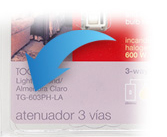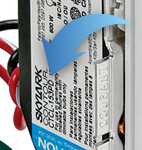
Explore Knowledge Articles
Back
MSCL-OP153M FAQ & Troubleshooting Guide
Troubleshooting the Maestro Motion Sensor/Dimmer

Lights don’t turn off after immediate room departure:
Default Timeout is 5 minutes after last detected motion. See Timeout Adjustment in the Programming Guide .
Do not want the lights to turn on when entering the room
The default setting is to turn the lights on when motion is sensed. To disable, please see Auto-On Adjustment located in the Advanced Programming menu. To do this Enter Advanced Programming then see page 8 for Sensor Mode Adjustment Instructions
After manual shutoff, the light will not automatically turn back on
When Auto-On is enabled, the sensor ignores motion for 25 seconds after manual shutoff. If the unit has never turned on after the timeout or when manually turned off, confirm that the model number is not the MSCL-VP153M as this model is Vacancy only and will not turn on with motion.
My Two-Location (3-Way) application with mechanical switch is not functioning correctly.
If using a mechanical switch in the second location check to make sure that you have made the wiring adjustment on the mechanical switch as seen below.

Also check that the MSCL-OP153M has been programmed to work with the mechanical switch. steps are listed below.

Lights sometime turn on when the sensor is in vacancy mode:
In vacancy mode, a 15-second "grace period" follows the timeout, where the sensor will turn the lights back on if it senses motion.
After installation or following a power failure, the lights will turn ON suddenly after the lights have been manually turned OFF.
The sensor takes up to 2 minutes to perform a calibration following a power cycle. If the lights are OFF and the calibration completes while the space is occupied, the lights will turn ON.
After installation or replacing the bulbs, the lights may not turn ON when turning ON the lights manually or when the space is occupied.
Check lights to make sure they show signs of compatibility and are in good working order. For example if only one light is wired to the dimmer and it fails, all indicator lights on the dimmer will not illuminate and the dimmer will not function until the light is replaced. If multiple lights are being controlled from the dimmer the dimmer will still operate if one of the lights fails. The Low-End Trim setting may be too low, this can be changed in the programming guide. Please see short cut HERE You may also want to try another type of light in the event the LED is incompatible. You can visit the LED compatibility at the following link for tested and approved LED lights. Lutron.com/ledfinder.
Can I use two Maestro sensors in a 3-Way Application?
No. You can use only one sensor in a 3-way. You'll need to use either a mechanical switch or a Maestro companion dimmer (model MA-R) in the other location. For 4-way applications, you'll need to use two Maestro companion dimmers with the sensor; you won't be able to use mechanical switches.
If I am using this with a mechanical switch, do I have to rewire the switch?
Yes. Please see location 2 in the diagram below which involves the use of the yellow jumper wire provided.

Will this work with low voltage LEDs?
No. Low voltage LEDs utilize either a magnetic or electronic low-voltage transformer. This control is not rated to dim these types of loads. To control such loads with a sensor switch the MS-OPS2 or MS-OPS5M would be better suited for the application pending the total wattage of the load.
Default Timeout is 5 minutes after last detected motion. See Timeout Adjustment in the Programming Guide .
Do not want the lights to turn on when entering the room
The default setting is to turn the lights on when motion is sensed. To disable, please see Auto-On Adjustment located in the Advanced Programming menu. To do this Enter Advanced Programming then see page 8 for Sensor Mode Adjustment Instructions
After manual shutoff, the light will not automatically turn back on
When Auto-On is enabled, the sensor ignores motion for 25 seconds after manual shutoff. If the unit has never turned on after the timeout or when manually turned off, confirm that the model number is not the MSCL-VP153M as this model is Vacancy only and will not turn on with motion.
My Two-Location (3-Way) application with mechanical switch is not functioning correctly.
If using a mechanical switch in the second location check to make sure that you have made the wiring adjustment on the mechanical switch as seen below.
Also check that the MSCL-OP153M has been programmed to work with the mechanical switch. steps are listed below.
Lights sometime turn on when the sensor is in vacancy mode:
In vacancy mode, a 15-second "grace period" follows the timeout, where the sensor will turn the lights back on if it senses motion.
After installation or following a power failure, the lights will turn ON suddenly after the lights have been manually turned OFF.
The sensor takes up to 2 minutes to perform a calibration following a power cycle. If the lights are OFF and the calibration completes while the space is occupied, the lights will turn ON.
After installation or replacing the bulbs, the lights may not turn ON when turning ON the lights manually or when the space is occupied.
Check lights to make sure they show signs of compatibility and are in good working order. For example if only one light is wired to the dimmer and it fails, all indicator lights on the dimmer will not illuminate and the dimmer will not function until the light is replaced. If multiple lights are being controlled from the dimmer the dimmer will still operate if one of the lights fails. The Low-End Trim setting may be too low, this can be changed in the programming guide. Please see short cut HERE You may also want to try another type of light in the event the LED is incompatible. You can visit the LED compatibility at the following link for tested and approved LED lights. Lutron.com/ledfinder.
Can I use two Maestro sensors in a 3-Way Application?
No. You can use only one sensor in a 3-way. You'll need to use either a mechanical switch or a Maestro companion dimmer (model MA-R) in the other location. For 4-way applications, you'll need to use two Maestro companion dimmers with the sensor; you won't be able to use mechanical switches.
If I am using this with a mechanical switch, do I have to rewire the switch?
Yes. Please see location 2 in the diagram below which involves the use of the yellow jumper wire provided.
Will this work with low voltage LEDs?
No. Low voltage LEDs utilize either a magnetic or electronic low-voltage transformer. This control is not rated to dim these types of loads. To control such loads with a sensor switch the MS-OPS2 or MS-OPS5M would be better suited for the application pending the total wattage of the load.
Was this article helpful?
Thank you! We appreciate your feedback!


